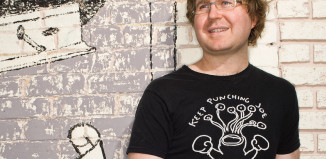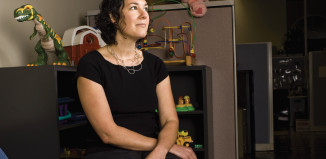A week in the life of a Ballet Austin company dancer: Wake early for morn ing workout at gym. Arrive at studio for daily hour-and-a- half ballet class. Rush through 15-minute break. Continue with seven more hours of physically exhausting dance rehearsal. Dance brilliantly. Leave studio in fatigued state and head back to gym for evening exercise session.
This has been dancer Reginald Harris’ life for the past four years, and he’s nothing if not grateful for it.
“At Ballet Austin, I think I’ve learned professionalism and how to be a professional dancer, how to learn choreography, how to enjoy what I do, but also how to maintain a certain sense of protocol,” Harris says. “When I visit other companies, I’m often struck by the lack of professionalism. So I have to give some props to my co-workers. Ballet Austin has remarkable dancers, true professionals with amazing work ethics.”
Harris has essentially grown up at Ballet Austin, at least his dance ability has. This ambitious 26-year-old moved to Austin in 2002 and, at the age of 20, his life changed in an instant. Harris joined Ballet Austin II – the organization’s apprenticeship program – and spent a year training under celebrated ballet master Truman Finney, an experience Harris says changed his understanding and approach to dance.
“Truman made ballet one cohesive school of thought,” Harris remembers. “He changed me as a dancer. I became more cerebral. The whole experience was just fantastic for me.”
After his second year as an apprentice, Harris was hired on as a Ballet Austin company dancer, an elite position held by only 20 dancers at any given time. It was then that Harris really began to shine.
“He’s a great example of a dancer who came to Ballet Austin with a good amount of talent that we were able to hone and develop,” says Stephen Mills, artistic director of Ballet Austin. “Reggie really matured in to such a lovely dancer.”
In his time as a Ballet Austin company dancer, Harris has performed integral roles in many ballets, but there are three particular pieces that he holds especially dear: “Hamlet,” “Desire and Three Movements” and “Light: The Holocaust and Humanity Project.”
Mills’ adaptation of “Hamlet,” which was a moving blend of classic and contemporary ballet, Harris calls “an absolute masterpiece.”
“Stephen is inspired by some deeper force,” Harris says. “That work was sleek and modern, but the story was told very clearly. It was visually stunning.”
With a principal role in Mills’ “Desire and Three Movements,” Harris was able to further explore his talents and push the limits of his ability. The second movement, the pas de deux, was specifically choreographed for Harris, and, despite the inherent responsibility involved, he willingly threw himself in to the role, and easily won over audiences with his grace and fluidity.
“Light: The Holocaust and Humanity Project,” Mills’ powerful and sublime ballet about the immense suffering and awe-inspiring survival stories of the Holocaust, required company dancers to thoroughly study the history of the event, partake in weekly discussions, view films on the subject and even speak with survivors.
“That was the first time I felt, as a dancer, that I was able to contribute to society a real sense of purpose,” Harris says. “It was wonderful to be part of a project that had a strong social commentary. It was a mark in my career that really raised the bar for me as an artist, particularly because of the amount of study that went in to that project. As I was dancing, somehow having that information in my head helped with the movement. The dance just came out of me. I felt like I never danced as consistently and as well, and I wasn’t even thinking about dancing.”
BORN TO DANCE
Harris’ love of ballet is so ingrained, and his studies have become so much a part of his being that his body naturally moves in a delicately graceful manner, even when he’s not dancing. It’s clear Harris possesses a keen understanding of the art and that he was meant to live a dancer’s life. Even as a child, his attraction to ballet was evident.
 “I don’t remember this, but my mother said I saw a performance of a ballet on PBS when I was young, and that’s what I wanted to do,” Harris reveals. “There’s a purity of the line that is exquisite to me, and there’s something about the architecture of the shapes in ballet that really speak to me.”
“I don’t remember this, but my mother said I saw a performance of a ballet on PBS when I was young, and that’s what I wanted to do,” Harris reveals. “There’s a purity of the line that is exquisite to me, and there’s something about the architecture of the shapes in ballet that really speak to me.”
Despite his dedication to the art of dance, Harris has struggled to overcome some deep-rooted stereotypes, particularly as a young, black, gay male in a world where there are few African-American male dancers, and of those, many are heterosexual.
“For some people, it’s still shocking to see black people in classical ballet,” he says. “I want to break those molds and not be labeled as anything other than a great dancer.”
Harris’ early-life role models provided plenty of proof that a successful dance career is a possibility for any young dancer with talent and perseverance. His uncle, Marshall Lindsey, taught African and modern dance in Chicago, and inspired Harris to start taking lessons at the age of five. Lindsey quickly became a mentor to Harris, who says his uncle’s passion for dance, his presence in the community and his command of a room helped the young Harris define his goals.
Sadly, Lindsey wouldn’t be around to witness Harris’ later success, as he passed away just months before Harris’ father died. At the age of 12, having just lost his father and his uncle, Harris could have fallen in to deep despair and given up dance altogether. Instead, he concentrated on the principles he’d learned from Lindsey, and fought hard to realize his dream of becoming a dancer.
“My father was a huge part of who I am, but my uncle shaped who I am and what I want to do with my life,” Harris says. “I’ll never forget him for that.”
Later, Harris’ search for an advisor who could pick up where his uncle had left off led him to a dance pioneer, another teacher whose tutelage would forever influence Harris’ life and career: Homer Bryant. A groundbreaking performer, Bryant was a principal dancer with the Dance Theatre of Harlem, and would later go on to found the Bryant Ballet school, the only African-American-run professional ballet school in Chicago. Harris trained with Bryant for six years in his teens, an experience he says empowered him and provided him with a deeper sense of ambition and appreciation for what lay ahead.
A HARD NUT TO CRACK
After graduating from high school, Harris continued his training in Philadelphia at the Pennsylvania Ballet School, where he mastered self-discipline, self-motivation and began to understand the importance of making himself seen and known in the dance world. The school was fast-paced and similar to big- company life, so Harris had to prove himself over and over again. But his commitment paid off, and in less than two years’ time, he had danced in scores of ballets for the school including “The Taming of the Shrew,” “A Midsummer Night’s Dream,” and 28 performances of “The Nutcracker.”
The lure of a scholarship soon took Harris to Seattle and the Pacific Northwest Ballet School, an institution widely regarded for its instructors and curriculum. But after only a year, Harris realized the school was not a good fit for him, in part because of a racially loaded incident that forced him to confront a brazen stereotype.
“I performed in 40 of the 45 ‘Nutcracker’ shows there,” Harris says. “But I was one of only two black guys at the school, and I was cast as a ‘first-class slave.’”
Harris says the awkwardness of the situation didn’t really sink in until he was in rehearsal, where he was regularly referred to as “slave.”
“I was certainly appreciative for the experience, but all of a sudden I felt like it was 1962, Montgomery, Alabama,” Harris says with a sense of hindsight humor. “So, it was just time to move on.”
DANCING TO A NEW TUNE
After a short few months grounding himself back at home in Chicago, Harris packed his dancing shoes and headed for Austin, a town that represented a fresh start and a new experience.
“Moving to Austin was definitely culture shock. I remember standing in line at Wheatsville and I realized this was a different kind of place,” Harris recalls. “The check-out person was commenting on the items I’d purchased with genuine interest. It just amazed me how nice that was. So it was really easy to get comfortable in Austin. Really great things have happened to me here.”
 Indeed, during one of his habitual trips to the gym three years ago, Harris met and fell in love with his partner, Aaron Shield, a linguistics Ph.D. student at the University of Texas. Though the two have had to face some challenges from society as an inter-racial and interfaith couple, they couldn’t be happier, and plan to wed next year in Shield’s hometown, Seekonk, Mass.
Indeed, during one of his habitual trips to the gym three years ago, Harris met and fell in love with his partner, Aaron Shield, a linguistics Ph.D. student at the University of Texas. Though the two have had to face some challenges from society as an inter-racial and interfaith couple, they couldn’t be happier, and plan to wed next year in Shield’s hometown, Seekonk, Mass.
“Despite our differences, we are so much alike,” Harris asserts. “We’ve both always been interested in the relationship between black and Jewish cultures, and we’re coming at it from a place of understanding. We really have such a wonderful relationship.”
While studying and dancing with Ballet Austin, Harris has discovered another love: choreography. He’s developed a talent for composition, and, in addition to choreographing numerous ballets for Ballet Austin II, he’s created works for the Ballet Conservatory of South Texas and the Dallas Ballet Center.
“I’m really interested in choreography. Ultimately, I’d love to have my own school or company. I want as many different dance experiences as possible, and to work with as many choreographers and styles as possible,” Harris expresses. “I’m 26, and this is the age that I could stay and make a career here, or I could make a big transition and do something a little different.”
Never one to walk away from an adventure, Harris is planning to pack all of his Ballet Austin experiences and move with Shield to Chicago this summer, where he’ll dance and likely choreograph with a small contemporary company called River North Chicago.
Though Harris still has plenty of years of dance ahead of him, moving in to the choreography realm enables him to pass along the lessons he’s gleaned from a wealth of illustrious and gifted instructors.
“The idea behind dance is not to think but to just be in the movement. When it’s good, you get in a zone, and when you’re in the zone you can take it to the next level and your body is able to do things you haven’t done before. That’s when dance is truly rewarding,” Harris says. “Dance is all about the preparation. You’ve prepared your body, technique and spirit to go out there on stage and share it with the audience. And, really, that’s what it’s all about. Dancing and performing is nothing to prove, only to share. That’s my motto.”




































